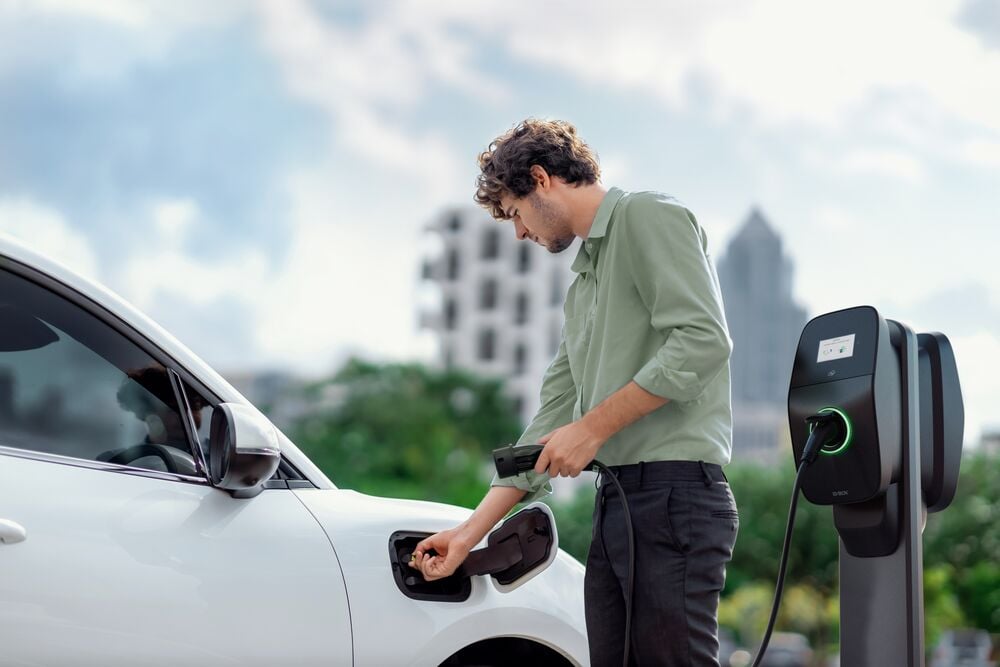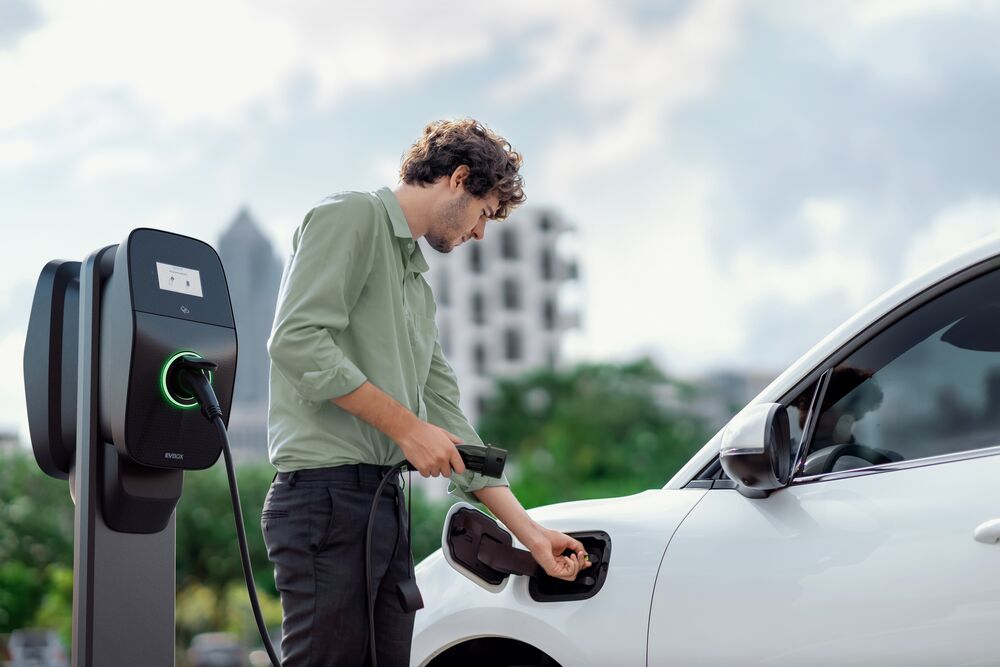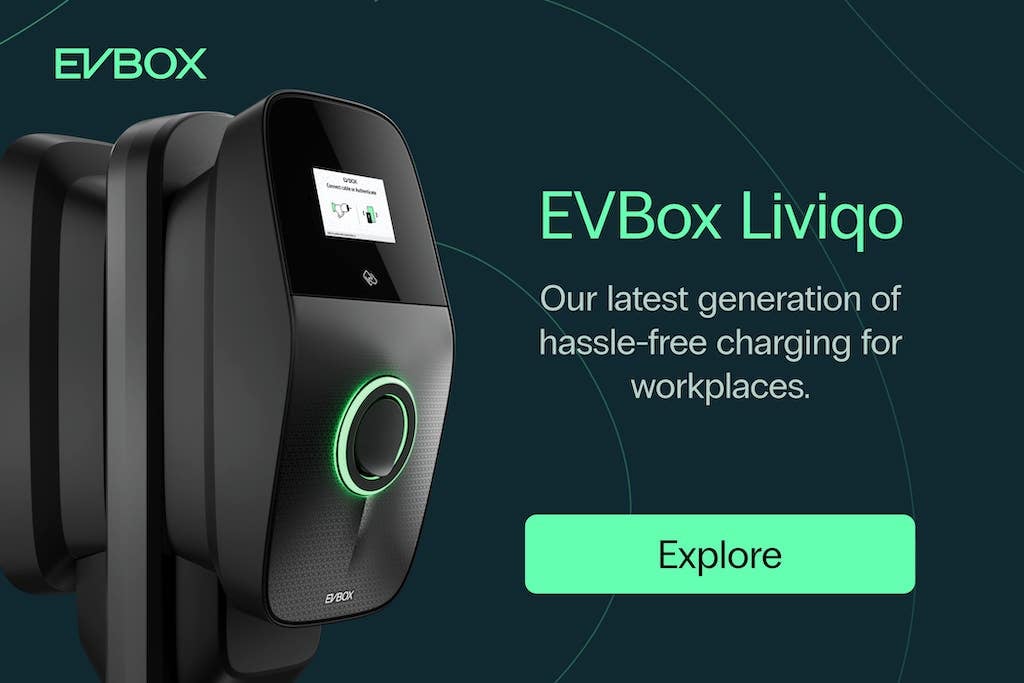
Installing EV charging stations at your workplace is a significant investment, so it’s important to assess your specific location and needs so that you can prepare properly, and end up with a charging solution that best meets your needs.
So, where to start?
To help you assess your location, we’ve compiled below 4 crucial things to keep in mind when picking a charging solution for your workplace:
-
Create an EV charging business case for your workplace
-
Prepare your workplace for installing EV charging stations
-
Conduct a detailed site analysis and evaluate the grid connection
-
Have a future-proof outlook
The rise of EV charging at the workplace
Electric mobility is rapidly gaining in popularity across the world, with new electric vehicle (EV) sales surpassed 10 million for the first time last year. It’s not surprising, then, that workplaces are increasingly looking at the opportunities presented by electric mobility.
One such opportunity is around EV charging. Workplaces are already the second-most popular charging locations for EV drivers, and this will only grow in the coming years as employees embrace electric mobility.
But offering EV charging requires a few more considerations than just buying a charging station and plugging it in. Importantly, you need to take into account your location’s specifics, as it will impact what’s feasible and practical from an EV charging perspective.
Let’s take a look below at 4 important aspects to think of when installing EV charging at your workplace.

1. Create an EV charging business case for your workplace location
Before looking at the practicalities of installing EV charging at your location, it’s worth taking a step back and considering the bigger picture. EV charging stations represent a significant investment, and you’ll most likely need to build a business case justifying that it’s worth it.
Beyond the simple cost of the equipment, it’s worth considering the demand for EV charging at your location, and determining a charging strategy that matches the use case and goals of your business. For example, you might want to offer complimentary charging to your employees as a benefit or for a discounted price, or you might even be able to monetize the use of your charging equipment – for example, by opening it up to the public for a fee.
There are also big differences between slow (AC) charging stations and fast (DC) charging stations that will have a big impact on what your EV charging offering will look like, the complexity of instalment, what it’ll cost, and how it is used daily.

It’s also worth keeping in mind that while you might be able to leverage government incentives, there can often be additional costs to install a charging station. Depending on your situation and the type of charging solution, you might have to work with your utility company to upgrade your connection to the grid or apply for permits from local authorities.
All of these steps can increase the cost and time it takes to install EV charging at your location, so doing your homework and taking a holistic view from the start is beneficial to anticipate any hurdles. Even more so, if you have more than one location.
What type of charging station do you need?
When thinking of what type and how many charging stations you’d need, it’s worth considering how they are going to be used. For one, are you offering EV charging primarily for your employees, or is it mainly for customers and guests?
While employees can stay at the office for the whole workday, guests and customers might only stay for a short time. Equally, your employees might travel to and from the office multiple times during the day, in which case they’d have less time to charge their EVs.

Depending on your needs, you might find that regular AC charging stations are enough to provide a full charge to employees at the end of the day. Alternatively, if your workforce comes and goes a lot, or if you’re primarily offering EV charging for customers, you might consider investing in DC fast chargers to allow for quick top-ups.
In practice, you might find that the solution that best meets your needs is a combination of AC and DC chargers, which can accommodate different users and is more flexible than having only one type of charging.
To learn more about how you can assess which charger best suits the demands of your workplace, check out our detailed article on the topic.
2. Prepare your workplace for installing EV charging stations
Once you have a business case ready, you might be wondering how you go about actually installing an EV charging station.
Like any electrical installation, it’s a bit more complex than just plugging it into your workplace’s existing electrical circuit. Because of the high power they deliver, EV charging stations have to be specially wired into your building, usually with a direct connection to your meter and circuit box.
This also means that if your meter is older or isn’t able to handle the extra power from EV charging, it might have to be upgraded to a more powerful version. Likewise, the specifics of your location and amount of charging stations and their respective power output will determine how much – and how difficult – installation work is required.
In any case, installing an EV charger is not something you can do on your own, and you’ll need to hire a qualified electrician for the process. This will increase the installation cost and is something to factor in from the beginning to avoid unpleasant surprises down the line.
3. Conduct a detailed site analysis and evaluate the grid connection
Of course, you cannot pick an EV charger without considering the setting it will be in. Various locations have different possibilities and constraints, and it’s worth understanding the specifics of your site before committing to a charging station.
Location-specific needs and limitations
One obvious aspect to address is parking space availability. Depending on your location, this might not be that much of an issue, but if your office parking is already usually full or of a limited size, you’ll have to consider which – and how many – parking spaces you convert to EV charging bays. It might also be worth considering having multiple charging ports per charging station so that multiple cars can charge simultaneously.
Given that the chargers will need to be connected to your power supply, it’s worth choosing a location with easy access to your building’s electricity circuit to minimize installation costs and disruption from construction work.
Size is also a factor to consider, as EV charging stations come in many different shapes and dimensions. Depending on the model, some chargers can be fixed directly to a wall or stand on their own.
There’s also a significant size difference between AC and DC chargers, the latter being considerably bulkier due to the equipment necessary to transform AC power from the grid into DC.
Electrical capacity and grid connection
When it comes to the impact of EV chargers on your building’s power supply, the number of chargers is a crucial determining factor. While a single charging station is unlikely to influence your electrical circuit, a dozen chargers will usually require an upgrade to your system.
Next to this, location plays a big role. It could be that you want to place chargers in a location where getting them hooked up to the grid is more costly than you expect. Sometimes moving them a few meters can already make a world of difference.
To understand what’s feasible with your current connection and what changes might be required, get in touch with your utility company and ask for an assessment of your location.
Getting more grid capacity is expensive
You’ll likely find that upgrading your building’s power supply is expensive. That’s exactly what Hanno Klausmeier, Director of SAP Labs France, found out when he had installed electric charging stations and called his utility company to request more capacity:
In fact, he didn’t have to. By leveraging a few creative solutions, such as integrating renewable energy sources, installing an on-site storage battery, and optimizing energy efficiency, he was able to forgo expensive upgrades to their grid capacity.
Oftentimes, you might be able to come up with creative solutions that cost less and will benefit you more in the long run but require taking a step back and analyzing the situation instead of spending on the first option presented to you.
If you’re interested in hearing more about the challenges of installing workplace chargers, you can listen to our Podcast episode.
4. Have a future-proof outlook
EVs are already important in today’s mobility landscape, but their current popularity is only a fragment of their future ubiquity. It’s worth making sure, then, that your EV charging installation will meet your company’s needs not only today but many years in the future.
This can be as simple as examining future EV ownership trends among your employees or customer base and factoring in a buffer to account for future EV growth. For instance, you may choose to build a few more charging stations than are needed currently or ensure the underlying infrastructure is ready to accept new charging stations without any significant upgrades.
Or as Linda Grave, CEO of EV driver said in a recent REVOLUTION Live podcast:
“Don‘t just build charging infrastructure that meets today’s requirements or needs, they should prepare for the next phase. And this starts with the groundwork, the construction, and everything you're laying, whether it be water, electricity, gas, or whatever it might be, this is the time to be thinking about future-proofing your site.” – Linda Grave
Other tips to get started with workplace EV charging
While the cost of installing EV charging stations is undoubtedly significant, it is often a worthwhile investment that helps attract new talent, boost employee satisfaction, support your sustainability strategy, or even generate revenue if you choose to open access up to the public.
What happens after you purchase and have installed the station is a whole other consideration that’s often overlooked. Maintenance, and the cost of servicing EV charging stations vary greatly depending on the number of chargers, ports, and type of charger. On top of the mandatory warranty and extended warranty offerings, many manufacturers offer maintenance plans that will help you keep your chargers performing optimally for years to come.
Preparing your business for the future of mobility
The writing is on the wall for combustion engine cars, with upcoming bans and ever stricter emissions regulations across the world. Investing in electric vehicle charging infrastructure is a clever way for businesses to complement their sustainability efforts and ensure they are ready for the future.
EV charging stations are not a one-size-fits-all solution, and the constraints and specifics of your location will impact which charger is best for your needs. If you’re looking to install EV charging stations at your workplace, have a look at our workplace solutions to learn everything you need to know.
Related articles

EV charging load management and the importance of cluster load balancing
Electric vehicle (EV) charging stations can add a substantial load onto your building’s power supply, often requiring...

How to install EV chargers at the workplace?
Regardless of the type or model of charger you choose (or how much one costs), installing EV charging stations is...

What do workplace EV chargers cost?
On average, AC workplace EV chargers tend to cost around €1,300 per charge port (excluding installation costs)....


